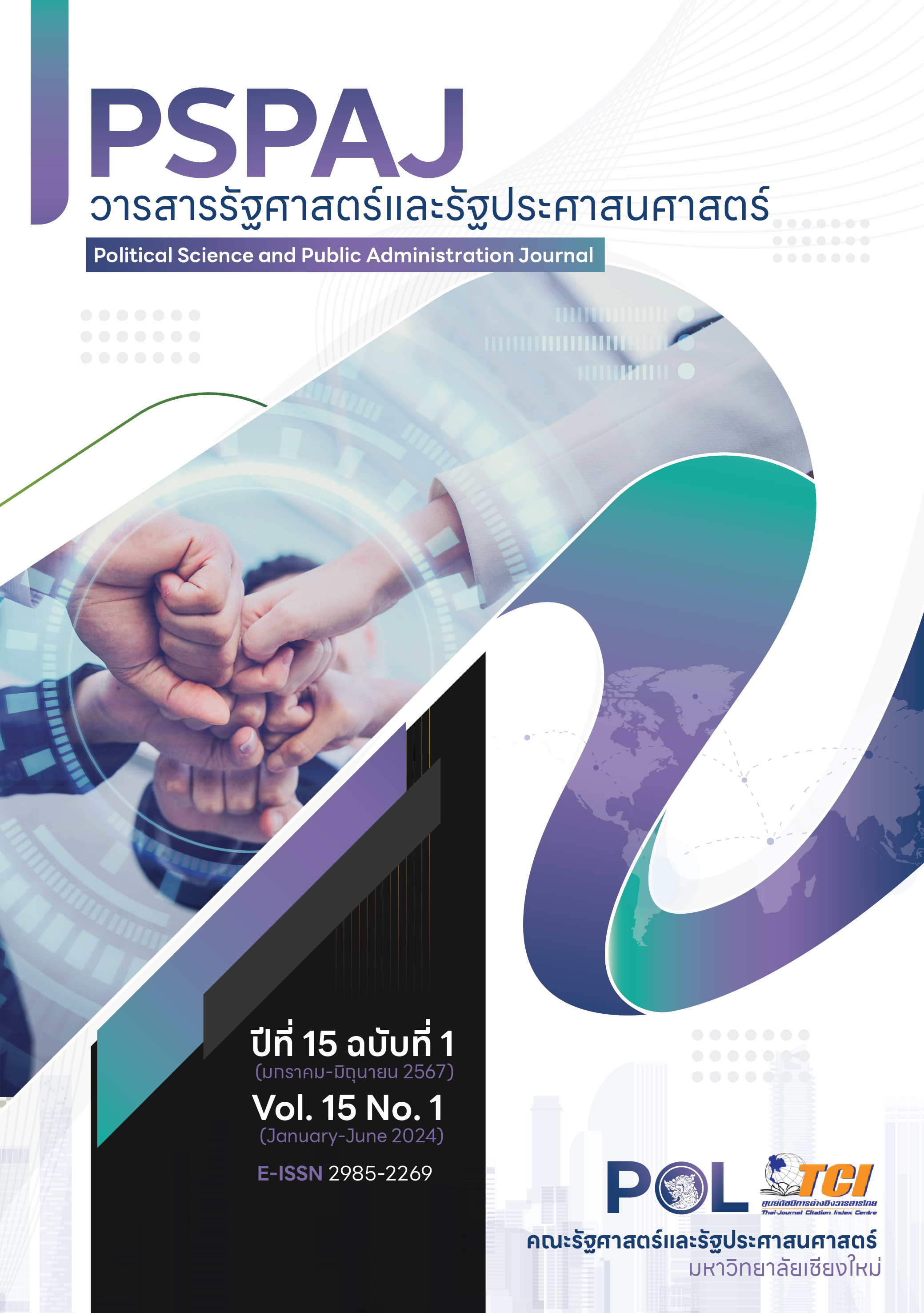Revenue Diversity and Performance Assessment of Local Administrative Organizations of Subdistrict and Municipal Administrative Organizations in Thailand
Main Article Content
Abstract
This study had the objective to investigate the relationship between Revenue diversity and the efficiency assessment of local administrative organizations in Thailand since the local administrative organizations currently have to mainly depend on the Revenue from the government. Consequently, the local administrative organizations lacked decision-making authority about the management of initiatives to create public services and manage resources appropriately for the people. Therefore, this study aimed to study the fiscal Revenue diversity generated through the performance of local administrative organizations through the equation for the analysis of the dependent variable data as fractions or percentages. The population this study included 7,774 local administrative organizations in Thailand through data collection in the fiscal year 2019. The findings revealed that Revenue diversity was related to the performance assessment scores of the local administrative organizations in Thailand with a statistical significance and reliability of 95%. It was explained that when Revenue diversity increases by 1 unit, the performance assessment scores of the local administrative organizations increase by 0.03%. According to the findings, policy recommendations are as follows: 1) The government should promote various forms of taxation by determining the revenue structure and imposing taxes and fees. 2) The study found that local government organizations had low-income diversity, with an average score of 0.4123. To improve public services, these organizations should prioritize collecting local taxes. 3) The municipalities and subdistrict administrative organizations should increase the efficiency of revenue collection to enhance the level of public services in the area by improving the law as a foundation for clearly determining the source of income of local administrative organizations in collecting income based on each area's context.
Article Details

This work is licensed under a Creative Commons Attribution-NonCommercial-NoDerivatives 4.0 International License.
- เนื้อหาและข้อมูลที่ลงตีพิมพ์ในวารสารรัฐศาสตร์และรัฐประศาสนศาสตร์ถือเป็นข้อคิดเห็นและความรับผิดชอบของผู้เขียนบทความโดยตรง ซึ่งกองบรรณาธิการวารสารรัฐศาสตร์และรัฐประศาสนศาสตร์ ไม่จำเป็นต้องเห็นด้วย หรือร่วมรับผิดชอบใดๆ
- บทความและข้อมูล ที่ได้รับการตีพิมพ์ในวารสารรัฐศาสตร์และรัฐประศาสนศาสตร์ ถือเป็นลิขสิทธิ์ของวารสาร หากบุคคลหรือหน่วยงานใดต้องการนำข้อมูลไปใช้ประโยชน์ในทางวิชาการ ขอให้อ้างอิงแหล่งที่มาด้วย
References
กรมส่งเสริมการปกครองท้องถิ่น. (2562). รายงานสรุปผลการประเมินประสิทธิภาพขององค์กรปกครองส่วนท้องถิ่น (สถ-อปท) ประจำปีพ.ศ. 2562. สืบค้นเมื่อ 20 สิงหาคม 2562, จาก http://www.dla.go.th/upload/ebook/column/2020/1/2286_6124.pdf
ไกรวุฒิ ใจคำปัน. (2563). เทคนิคสถิติสมการถดถอยเชิงพหุ พร้อมบทเรียนจากการวิเคราะห์ภาษีที่ดินและสิ่งปลูกสร้าง. ใน วีระศักดิ์ เครือเทพ, ศิวาภรณ์ ไชยเจริญ, ไกรวุฒิ ใจคำปัน, และดวงมณี เลาวกุล (บ.ก.). แนวโน้มการศึกษาและเทคนิควิธีวิจัยด้านการคลังท้องถิ่น (น. 79-91). กรุงเทพฯ: สำนักพิมพ์จุฬาลงกรณ์มหาวิทยาลัย.
นราธิป ศรีราม, จิรวัฒน์ เมธาสุทธิรัตน์, และอภิชาติ ลิ้มเมธี. (2560). การจัดสรรงบประมาณให้แก่องค์กรปกครองส่วนท้องถิ่น: เสริมสร้างหรือบั่นทอนความอิสระทางการคลังของท้องถิ่น. วารสารศิลปศาสตร์ มหาวิทยาลัยอุบลราชธานี, 13(2), 191-216.
ดิเรก ปัทมสิริวัฒน์, และพิชิต รัชตพิบุลภพ. (2553). การวิเคราะห์คะแนนสรุปการทำงานขององค์กรปกครองส่วนท้องถิ่น. วารสารเศรษฐศาสตร์และนโยบายสาธารณะ, 9(18), 91-108.
ไททัศน์ มาลา. (2554). การปกครองท้องถิ่นไทยในระยะเปลี่ยนผ่าน. วารสารวไลยอลงกรณ์ปริทัศน์, 1(2), 29-49.
วีระศักดิ์ เครือเทพ. (2554). ความเหลื่อมล้ำทางการคลังของเทศบาล: บทสำรวจปรากฏการณ์ “ใครมีเงินมากยิ่งได้มาก”. วารสารเศรษฐศาสตร์และนโยบายสาธารณะ, 2(4), 18-42.
สำนักงานป้องกันและปราบปรามการทุจริตแห่งชาติ. (2562). คู่มือการประเมินคุณธรรมและความโปร่งใสในการดำเนินงานของหน่วยงานภาครัฐ พ.ศ. 2562. กรุงเทพฯ: สำนักประเมินคุณธรรมและความโปร่งใส.
Carroll, D. (2005). Are State Governments Prepared for Fiscal Crises? A Look at Revenue Diversification During the 1990s. Public Finance Review, 33(5), 603-633.
Carroll, D. (2009). Diversifying Municipal Government Revenue Structures: Fiscal Illusion or Instability? Public Budgeting & Finance, 29(1), 27-48.
Hendrick, R. (2002). Revenue Diversification: Fiscal Illusion or Flexible Financial Management. Public Budgeting & Finance, 22(4), 52-72.
Suyderhoud, J. P. (1994). State-Local Revenue Diversification, Balance, and Fiscal Performance. Finance Review, 22(2), 168-194.
White, F. C. (1983). Trade-off in Growth and Stability in State Taxes. National Tax Journal, 36, 103-114.


